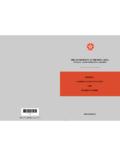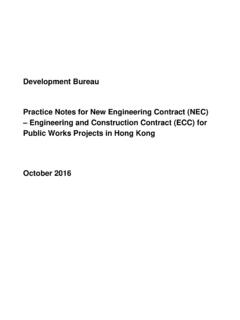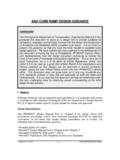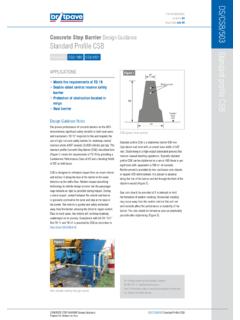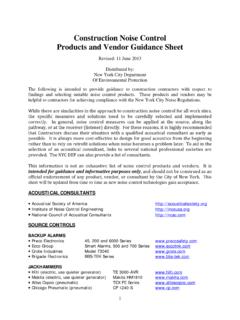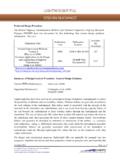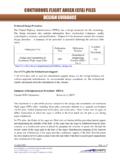Transcription of Guidance Notes on Construction Design and …
1 Guidance Notes on Construction Design and management Table of Contents Chapter 1 Introduction Chapter 2 Getting Organized for CDM Chapter 3 The Deliverables Chapter 4 Administration of the CDM Process Chapter 5 Hazard Identification and Risk Control Appendix A Proforma for "Summary of Health and Safety Concerns" Appendix B Proforma for "Hazard and Impact Summary" Appendix C Coverage of a "Pre-tender Health and Safety Plan" Appendix D Examples of Issues to be Addressed at Preliminary Design Stage Appendix E Sample Entries into the 'Risk Register' under ETWB Technical Circular No. 6/2005 Appendix F Risk Assessment Method 3 4 7 11 17 22 24 26 29 30 31 2 Guidance Notes on CDMD isclaimer "The book is not for sale and is provided solely for reference purpose. The Environment, Transport and Works Bureau (ETWB), the Hong Kong Housing Authority (HKHA) and the Occupational Safety and Health Council (OSHC) are the owners of all copyright subsisting in this book.
2 All unauthorized copying or reproduction in any means of this book or part of it is strictly prohibited. ETWB, HKHA and OSHC make no warranty with respect to the accuracy and completeness of the contents of the book and should under no circumstances be held liable for providing such information." Guidance Notes on CDM Chapter 1 Introduction Background In January 2001, the Construction Industry Review Committee (CIRC) appointed by the Chief Executive of the Hong Kong Special Administrative Region stressed that site safety was a shared responsibility of the regulator, employers and employees. It also suggested that to achieve better safety performance in the whole project life cycle, hazards identification and mitigation should start from the early Design stage and be carried through subsequent phases of project development, implementation, maintenance and demolition.
3 The CIRC considered that the model under UK's Construction ( Design and management ) Regulations (CDM Regulations) might provide a basis for achieving the above objectives. The UK model emphasized that stakeholders including clients, designers and contractors should contribute towards the avoidance, reduction and management of health and safety risks during all stages of a project. The Essence of CDM This new paradigm of Construction safety management is referred to as ' Construction Design and management ' (CDM) in this Guidance Notes . The main objective of CDM system is to achieve: i) Identification of potential health and safety hazards, and cost-effective mitigation measures at early stage of a project and continue throughout project delivery; ii) Early involvement and effective co-operation of all stakeholders through timely provision of relevant and necessary information; and iii) Clear demarcation of the roles and responsibilities of the parties responsible for coordinating and providing relevant project data on risks at all stages of a project.
4 The former Works Bureau [now part of the Environment, Transport and Works Bureau (ETWB)] and the Housing Authority (HA) have taken the lead to explore the use of the CDM approach by incorporating practicable features of the UK's CDM model for trial implementation in public works and public housing projects. This Guidance document is prepared based on the experience gained from the trials with due emphasis placed on the importance of integrating the CDM system with existing project management process in order to ensure balanced considerations be given to all aspects of a project. 3 Guidance Notes on CDM Chapter 2 Getting Organized for CDM Who is responsible for implementing CDM? The following parties having specific roles to play in the CDM process are called duty holders. They are: (a) Client; (b) Project Supervisor (usually the lead designer); (c) Designer (architect/engineer/maintenance surveyor); (d) Contractor (including principal contractors and sub-contractors); (e) Contract Supervisor (the client's [or consultant] appointed site representative); and (f) Maintenance Supervisor (the client's or end user's representative supervising maintenance works).
5 Roles and Responsibilities of Duty-holders The roles and responsibilities of the duty-holders are summarized below: (a) Client Client has the responsibility to check the competence of everyone he appoints, and should allow enough time and resources for all stages of a project; Client should appoint a competent Project Supervisor and ensure that his job is done properly; appoint a competent principal contractor; check if there is a pre-tender health and safety plan before tendering; Client must ensure that the Project Supervisor has sought all the health and safety information likely to be needed. This information becomes the health and safety file and the client should take reasonable steps to ensure the information is made available for inspection by any person for further planning and maintenance of the project ; and Client should set up health and safety goals, possibly with performance indicators and establish a performance monitoring system.
6 4 Guidance Notes on CDM (b) Project Supervisor The Project Supervisor is responsible for advising and assisting the client with his duties; co-ordinating Design work; managing communications between client, designers and contractors; liaising with the contractors about ongoing Design matters; ensuring that the health and safety file is created, updated and properly managed. The Project Supervisor should be a suitably experienced professional of sufficient seniority commensurate with the complexity of the project. Normally this person would be the senior architect/ engineer/maintenance surveyor managing the project. If the project is managed by consultants, a competent Project Supervisor should best be provided by the lead consultant. For Design -and-build projects, the contractor should be required to appoint a Project Supervisor to prepare and update the health and safety file during the Design and constructions stages.
7 (c) Designers Designers can be the architects/engineers/maintenance surveyors who contribute to or have responsibility for the Design and/or drawing up of the specifications of any part of the project works. For the purpose of this document, the architects/engineers/maintenance surveyors are collectively called the 'designers' in subsequent chapters. In Design -and-build projects, the contractor should appoint a competent professional to undertake the duties of the designers. The role of a designer is to identify and minimize hazards which may give rise to risks; reduce risks due to Design and inform relevant parties of the remaining risks; cooperate with the Project Supervisor and other designers; provide information for incorporation into the health and safety file. Health and safety is a shared responsibility. Although designers play a vital part in control and management of health and safety hazards, management of risks during the Construction stage is still the contractors' responsibility.
8 Therefore, designers are not expected to eliminate all the risks that will arise during Construction and subsequent maintenance and operation stage, but are required to address the risks where it is reasonably practicable to do so within the constraints at the time of preparation of the Design . 5 Guidance Notes on CDM (d) Contractor The principal contractor should plan, manage and monitor the Construction phase in liaison with other contractors; prepare, develop and implement a Construction health and safety plan; ensure that suitable welfare facilities are provided throughout the Construction phase; check the competence of their appointees; and liaise with the Contract Supervisor about ongoing Design matters etc. A person conversant with the details of the works should be appointed by the principal contractor for liaising in CDM matters. (e) Contract Supervisor and Maintenance Supervisor Both will have to assure their own competence, cooperate with others, report obvious risks, and provide any information required for the health and safety file.
9 These people should have professional background in Construction . Whilst individual departments for the CDM implementation may differ in other organizations and the nature of projects may also vary, the roles of duty holders may therefore need to be adjusted to suit individual circumstances. Nevertheless, it is more important that a considerate culture throughout the process of project Design , development and maintenance be nurtured by means of the CDM spirit and concept. Example The following example is given to illustrate the relationship between the various duty holders of a project: The Architectural Services Department (ArchSD) receives an assignment from the Hospital Authority for the Construction of a new hospital and the Design work is assigned to a specialist Design consultant. Under such circumstances, the Hospital Authority will be the end-user, ArchSD will be the client acting on behalf of the Hospital Authority, and the project manager of the Department will be the Project Supervisor and responsible for the appointment of designers.
10 But this is not the only possible mode. For other situations, the lead consultants may be responsible for the appointment of the Project Supervisor and the designer from their own office. The role of the Contract Supervisor is best, but not necessarily, to be taken up by the project architect/consultant responsible for the contract administration for the project. There is no hard and fast rule. Departments should consider how best to perform each role. CDM Implementation Level For projects where the works may be divided into different identifiable locations or portions, and are covered by different consultancies, for practicable consideration the CDM process may be implemented based on those 'natural' boundaries of responsibilities. 6 Guidance Notes on CDM Chapter 3 The Deliverables Documents The most important deliverable of the CDM process is the health and safety file, which is a folder containing the relevant health and safety information necessary for effective control and management of risks throughout the life of a project.


